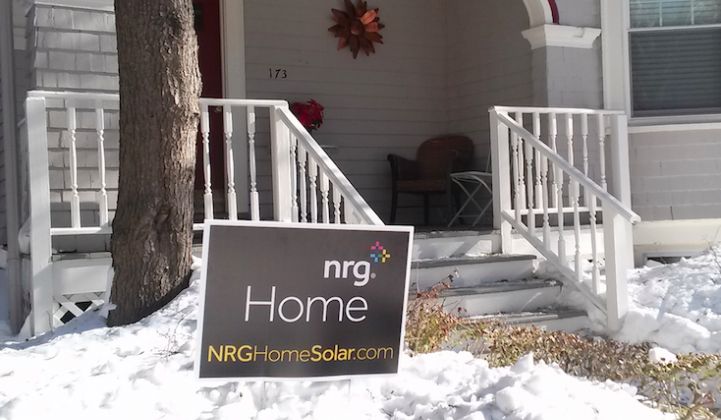NRG Energy is shedding the remains of its residential solar installation business in an attempt to find a sustainable model in the tumultuous rooftop PV market.
According to sources, employees were informed today that the solar unit, called NRG Home Solar, will be downsized once more. In May of last year, the company laid off 500 employees, pulled out of three states, moved the residential solar business back under the retail arm, and began outsourcing financing and installations to third parties.
GTM was unable to confirm the most recent number of layoffs. However, it learned that employees on the sales team received notice today. The remaining installation team will be impacted in the coming weeks after completing backlogged projects.
The solar business will be a shadow of its former self.
NRG, one of America's biggest independent power providers, will now simply generate leads through its retail business and pass them on to third parties.
The move is a dramatic reversal from NRG's solar buying spree in 2014, when it acquired the eighth-biggest U.S. solar installer, Roof Diagnostics, as well as the portable solar company Goal Zero. That year, Tom Doyle, then the CEO of NRG's solar business, declared his intention of giving national installers like SolarCity "a run for their money."
That national expansion may have been too aggressive.
In 2015, NRG Home Solar became the fourth-biggest residential solar installer in the country. It also lost $175 million. With the power provider's stock under pressure, investors forced the company to rethink its solar strategy and ousted then-CEO David Crane at the end of the year.
Five months later, in May 2016, NRG Home Solar announced its restructuring plan. It pulled out of California, Connecticut and North Carolina in order to focus on Massachusetts, New Jersey and New York. It also scaled back installation crews and stopped offering direct financing, choosing instead to partner with Spruce Finance and Sunrun for those services.
According to one former manager at NRG Home Solar, the move was necessary in order to cut out "dead weight."
After the Roof Diagnostics acquisition, "there were too many layers of management that weren't needed," said the source. "Having been through some of that myself in this industry, I knew it was a good move."
Installations fell in the following quarters. According to GTM Research's U.S. PV Leaderboard, NRG Home Solar's market share fell from 1.9 percent of the total residential market in the first quarter of 2016 to 0.7 percent in the third quarter. Volume dropped from 11.6 megawatts to 4 megawatts during that same time period.
After de-emphasizing residential solar, NRG is now ready to leave the business entirely.
"NRG tried to make it work, and at the end of the day we just weren't making progress," wrote one employee.
NRG is not ending its solar offering entirely, said a company spokesperson. Rather, it will simply become a lead generator for other installers.
"In May 2016, we made a commitment to both our employees and our investors that we would restructure this business to be a profitable one -- consistent with what we expect from all of our businesses. After significant improvements and a diligent assessment, we have determined that the best way to achieve that commitment is to pivot to this new business model," wrote the spokesperson in a statement to GTM.
Meanwhile, NRG's utility-scale, commercial-scale and community solar businesses are going strong. Last September, the company won a bid for 1.5 gigawatts of SunEdison's solar and wind assets. It also completed multiple community solar projects in Massachusetts in 2016, with others in Minnesota and New York in the pipeline. NRG now operates 4 gigawatts of renewable energy projects around the U.S., with 2.6 gigawatts in some phase of development.
It's been a tough couple of years for residential solar companies since NRG entered -- and exited -- the market. Sungevity is on the verge of bankruptcy. Next Step Living shut its doors (after NRG bought its solar business). Verengo went bankrupt (and NRG bought its Northeast assets as well). Vivint Solar nearly collapsed after getting acquired by now-bankrupt SunEdison. And some argue that Tesla's acquisition of SolarCity was a way to hide the solar installer's shaky financial performance.
Meanwhile, installations keep growing at a record pace. According to the latest figures from GTM Research and SEIA, America's solar market grew 95 percent last year -- surging from 7.4 gigawatts in 2015 to 14.6 gigawatts in 2016.



